Reverberation is the major interference for active sonar in underwater target detection. Ocean reverberation is the superposition of all indirect echoes caused by the sea bottom, sea surface, sea animals and the inhomogeneous water. The characteristics of reverberation and the direct echo signal are very similar in time and frequency domains. The detection performance of sonar seriously degrades using conventional time-frequency signal processing to distinguish the target echo from these reverberations. Direct echo signal detection under strong reverberations is a challenging problem in active sonar signal processing.
Typically, the spatial filtering technique based on the beamforming is one of the effective ways for anti-reverberation. The reverberation can be effectively suppressed by the beamforming technique[1]. However, a superior performance of spatial filtering method requires an array with a large number of sensors and an ideal shape. In many practical applications, it is not feasible. The matched filtering method is considered to be an optimal detector under the condition of Gaussian white noise background. Typically, ocean reverberation is not Gaussian white noise, and the performance of matched filtering can be degraded for anti-reverberation[2-3].
Several methods were proposed to suppress non-Gaussian reverberation. The first one is increasing procession gain by whitening the reverberation using reverberation statistical models, and the method works well when reverberation statistic models are known [2-5]. The second one is the model based on matched filtering using the characteristics of the ocean channels[6-7], which requires the transmission model of the underwater sound channel.
Echo detection based on differences between echo and interference characteristics is a different method of anti-reverberation[4, 8-11]. Those methods fully utilize the target’s physical characteristics of an underwater echo. In this paper, the broadband underwater target echo detection under reverberation based on the echo spectral irregularity feature is one of these methods.
According to the classical acoustic resonance scattering theory[12-15], the scattered acoustic pressure consists of two main components: A non-resonant background that varies smoothly with frequency, and a resonance component characterized by a series of echoes corresponding to resonance frequencies. The resonance components of these targets cause strong notches and peaks in the echo spectra, which depends on target elastic properties (e.g., bulk density and elastic constants), and the non-resonance components from geometric reflection result in a smooth background. The resonances of an elastic object can be regarded as its fingerprints. Resonance scattering feature extraction applied to air-filled, cylindrical shells in water can provide accurate target parameter estimation[16]. The elastic scattering wave and geometric wave are combined in the time domain and the frequency domain. For a complex target echo signal, the extraction of elastic acoustic scattering feature is not feasible.
Underwater target echo spectrum is the characterization of an echo in the frequency domain. The fluctuation of the echo envelope closely relates to the physical parameters of the target, by which the envelope of incident signal spectrum is modulated. The echo spectrum is modulated by geometrical scattering and elastic scattering, and the same resonance scattering model modulates the echo spectrum by equal intervals. The envelope modulation characteristics of the echo are greatly influenced by the physical parameters, such as material, structure, dimension scale, etc. The modulation feature of echo spectrum can be useful for underwater target classification[17-20]. Studies have shown that the spectral features of the echoes, such as frequency shifts in the peaks and nulls of the echo spectrum, have been used by the whales and dolphins to discriminate between echoes of different prey[21-24]. All previous studies show that the echo spectrum contains the information of the target being detected.
In shallow water, the reverberation caused by the interface is the main interference for active detection, and the magnitudes of reverberation caused by the sea bottom and sea surface are different. The magnitudes of echo in time and frequency domains are significantly modulated by the two kinds of reverberation. Normally man-made targets have a regular shape and smooth surface, and accordingly the magnitude differences of the echo highlights are small and the fluctuation of the echo spectrum is also relatively small. For discrimination between the broadband echo of the underwater man-made target and reverberation, the irregularity characteristics of the spectrum envelope are studied and characterized with spectral irregularity (SI) for echo and reverberation.
In this paper, a novel method is proposed to discriminate broadband underwater target echo from reverberation based on the relationship between signal spectral irregularity and the target’s physical properties. The results of theoretical simulation and sea test show that the spectral irregularity of underwater man-made target broadband echo and reverberation have clear differences, and target echo and reverberation can be distinguished well using the proposed methods.
1 Characteristics of Spectrum Fluctuation
1.1 Magnitude fluctuation of echo spectrum
Echo spectrum is the product of the spectrum of underwater target scattering function and the incident signal. The fluctuation of the underwater target echo spectrum contains the physical properties of the target, and the feature of the spectral fluctuation is used to discriminate underwater target from reverberation.
Fig.1 and Fig.2 show the typical examples of the scattering form functions for the steel cylinder and ball of normal incidence, respectively, where ka is the nondimensional frequency parameter and the computation is carried out with the following parameters:
Steel: ρ1=7.9×103 kg/m3, cl=5 940 m/s, ct=3 100 m/s
Water: ρ=1.0×103 kg/m3, c=1 500 m/s
Comparing the functions of geometric scattering with elastic scattering, the magnitude of geometric scattering function fluctuates slightly in the low frequency band and relatively flat in the high frequency band, which relates to the low frequency modulation of the echo spectrum. The elastic spectrum possesses extensive fluctuation, which closely relates to the physical properties of the target and high frequency modulation of the echo spectrum magnitude.
The entire spectral envelope fluctuation presents the combined influence of the geometric and elastic scattering waves. For a complex underwater target, both the structure and shape greatly influence the scattering spectrum. Fig.3 is the scattering form functions for steel benchmark model in two different azimuths, in which the azimuth of 90° is defined as normal incidence, and the azimuth of 0°is the direction of incident from the stem. As a typical complex target, the model of benchmark was established for an international workshop on target strength simulation methods[25]. The simulation results show that the scattering function varies greatly with azimuth, which is more complex in the bow and stem direction, demonstrating the azimuth influence on the scattering form function, and also show the relationship between physical properties and fluctuation of spectrum magnitude.
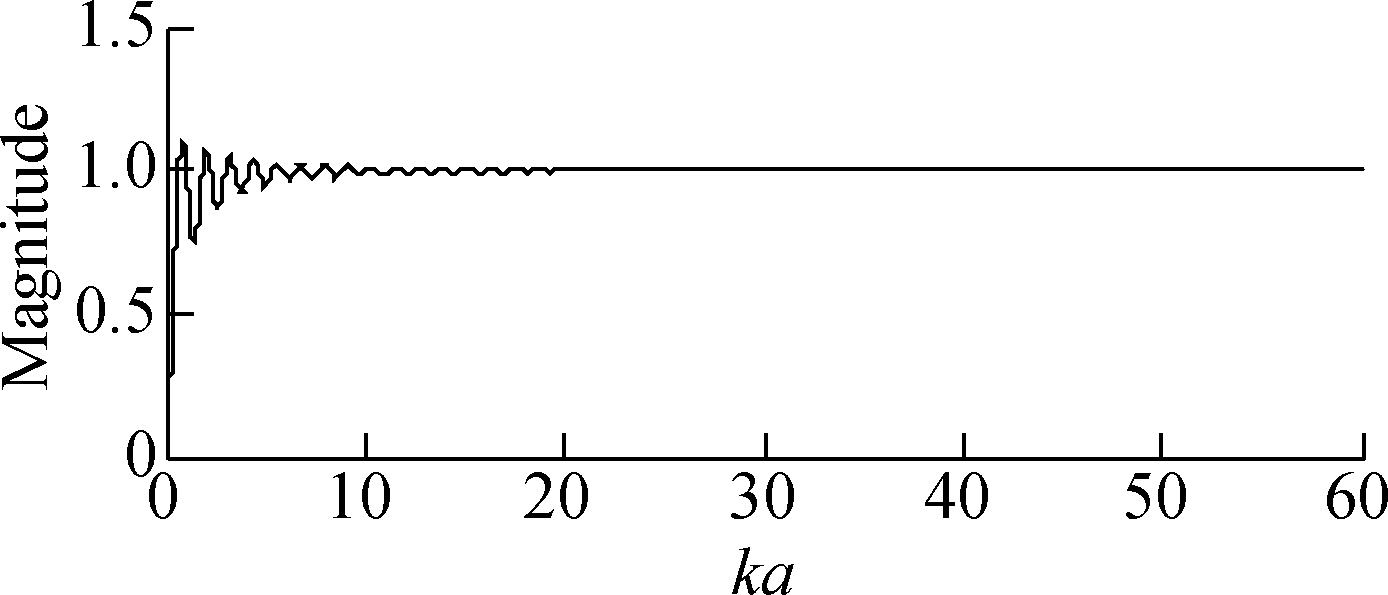
(a)
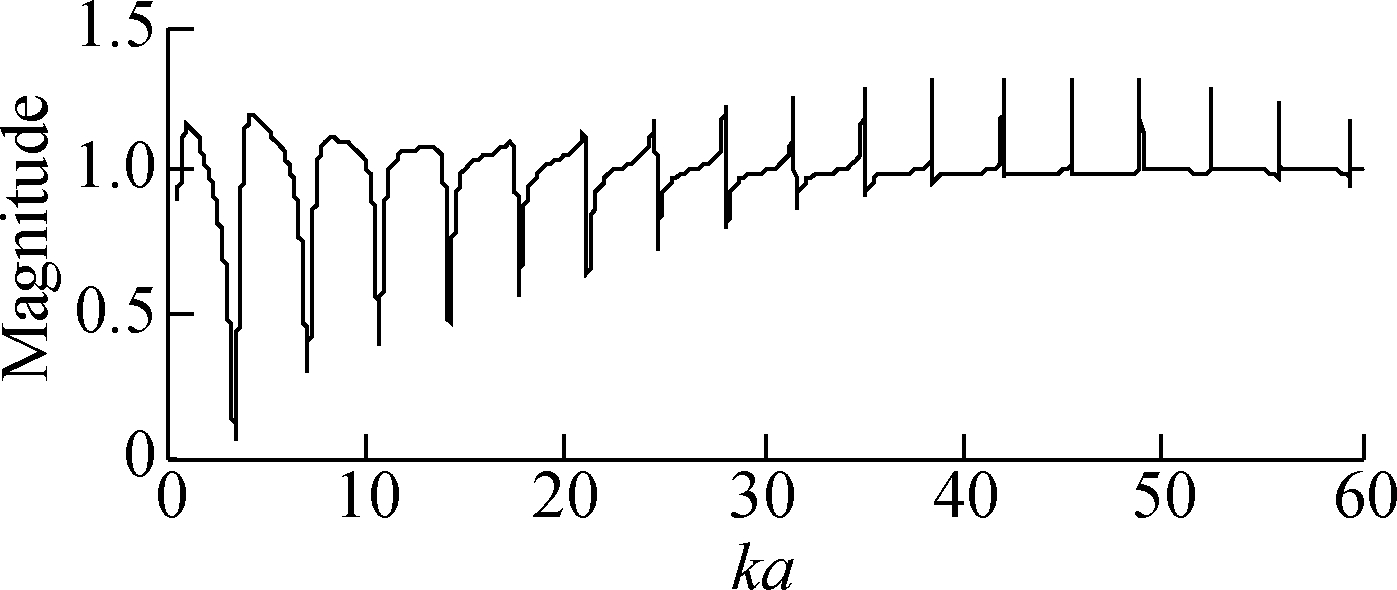
(b)
Fig.1 Theoretical form functions for rigid and elastic cylinder. (a) Rigid; (b) Elastic
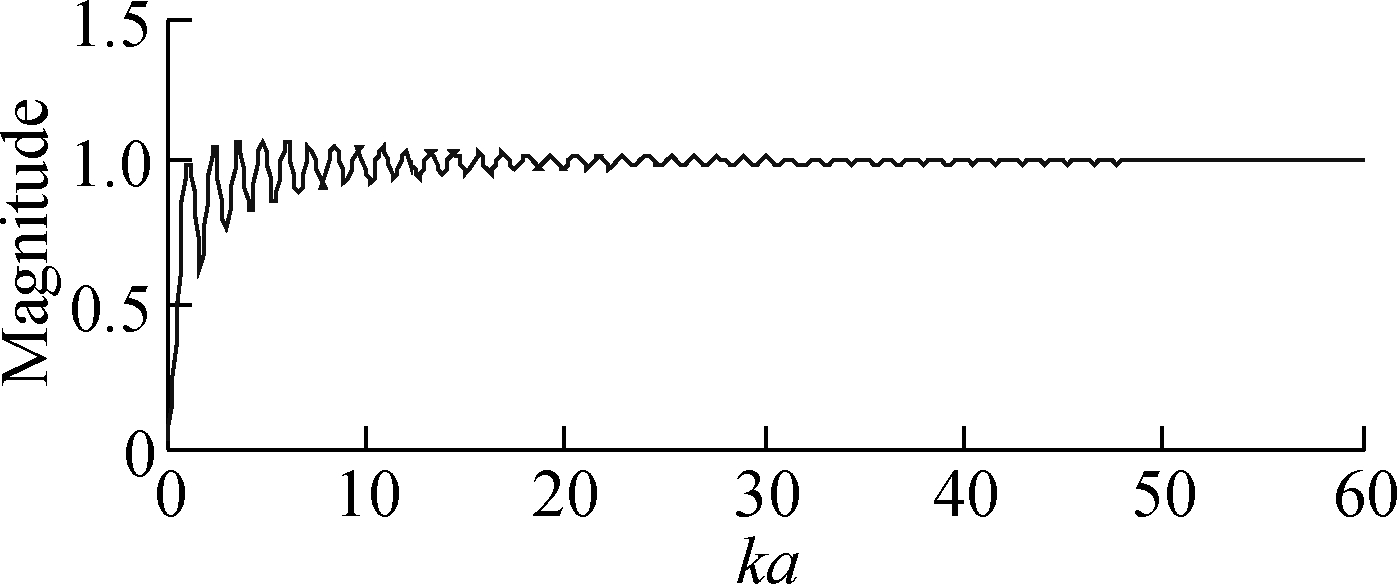
(a)
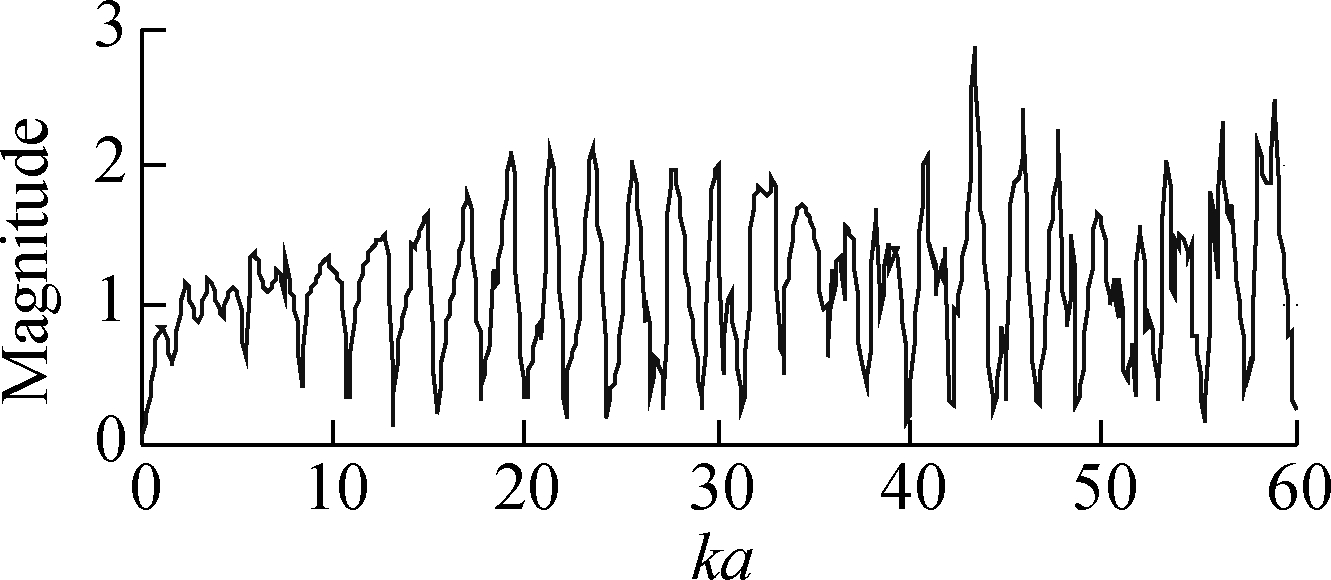
(b)
Fig.2 Theoretical form functions for rigid and elastic ball. (a) Rigid; (b) Elastic
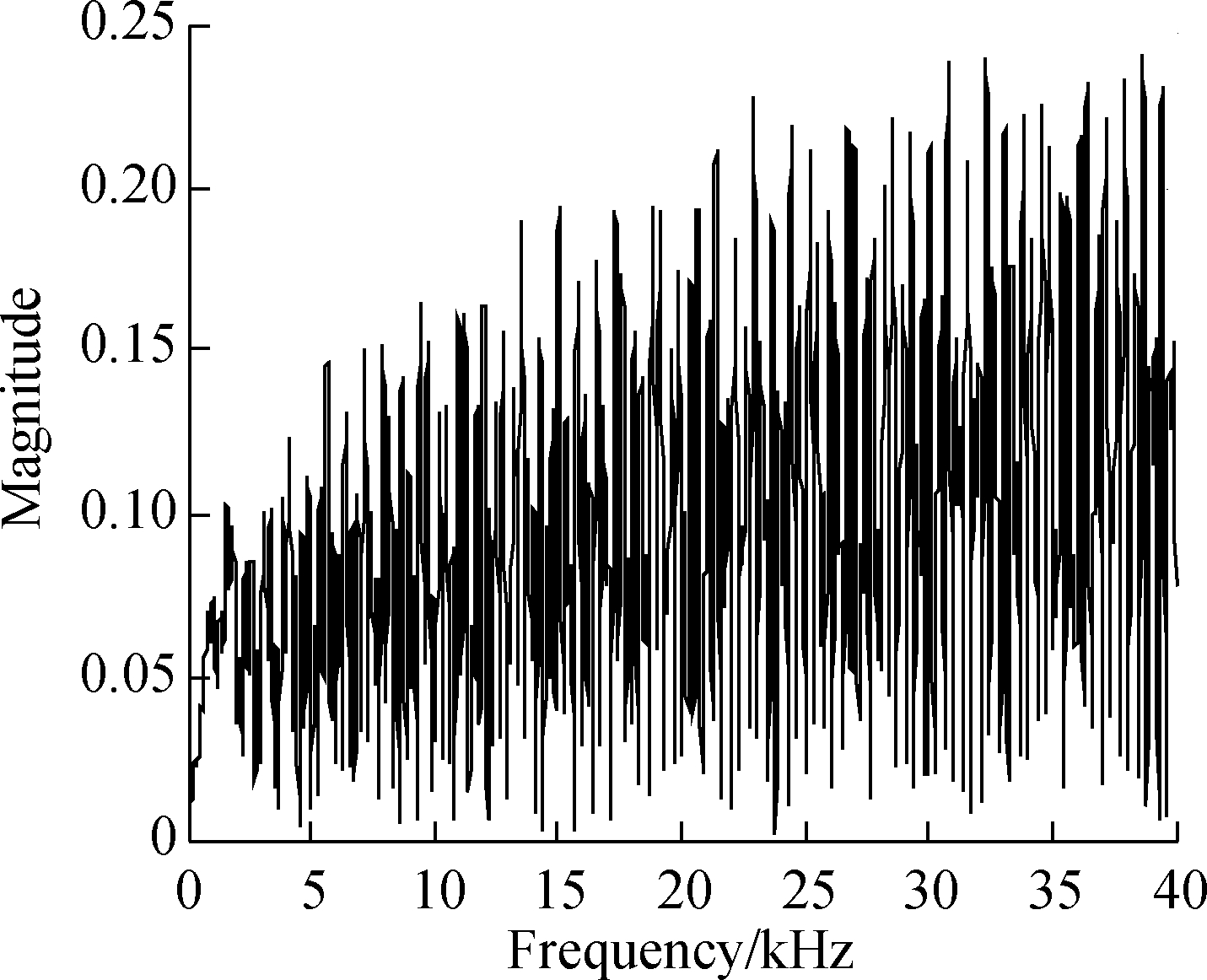
(a)

(b)
Fig.3 Form function for the benchmark. (a) 0°; (b) 90°
1.2 Feature of reverberation spectrum
Reverberation is the superposition of indirect echoes produced by the sea bottom, randomly undulatory sea surface and inhomogeneous sea water. Unlike the sea environment noise, reverberation is caused by the transmitting signal and increases with the increase in the intensity of it. The reverberation has much resemblance to that of transmitting signal, which is often considered as non-stationary colored noise[26]. According to the three different spatial distributions of the scattering wave, the received reverberation at a certain time is the superposition of the three types scattering waves. For analyzing the reverberation spectral envelope characteristic, the simulation of reverberation is based on the following assumptions[27]:
1) The secondary scattering effects are assumed to be negligible, and the scattering waveform is identical to that of the transmitting signal.
2) The reverberation caused by the bottom and sea surface is included in the shallow water.
3) Monostatic transmitting and receiving configuration are assumed.
4) Sound propagates along a straight line with spherical spread transmission loss.
5) Absorption is not taken into account.
6) The scattering of the sea bottom meets the Poisson distribution law.
Reverberation is the scattering wave of a large number of scatters with random distribution, which can be expressed as
(1)
where Sr(t) is the reverberation; N(t) is the number of scatters in time t; φi is the Doppler frequency shift caused by the motion of the i-th scatter; Ai(t) is the magnitude of the scattering wave caused by the i-th scatter in time t.
According to the reverberation forming mechanism, the contribution of all scattering wave that constitutes the whole reverberation is very small. The instantaneous value of reverberation should accord with Gaussian distribution, and the phases of scattering wave caused by the scatters are random. Especially, for broadband reverberation, the magnitude and phase are all random, and thus the phases of reverberation are random for different times. Therefore, the spectral irregularity of broadband reverberation does not have notable time varying characteristics.
1.3 Spectral envelope irregularity
The theoretical calculation shows that the form function of benchmark varies with azimuth, and its mechanism characteristic will be introduced in this section. The scattering wave of the complex underwater targets consists of geometric reflecting echo and various elastic waves based on the echo highlight model. The echo of the complex target can be expressed as[28]
(2)
where y(t,θ) is the echo with an incident angle of θ; x(t) is the incident signal; an(θ) is the strength coefficient of the n-th echo highlight; b(t) is the echo background signal. Assuming that the echo highlights are equally spaced on the target; N is the number of echo highlights; and τn is the receiving time delay between the n-th echo highlight and the start of the echo signal.
(3)
τn=(n-1)τθ
(4)
(5)
where L is the lengthwise length; C is the sound speed in water; and the frequency domain expression (Eq.(2)) can be expressed as
(6)
where s(f,θ) is the frequency domain expression of y(t,θ); X(f) is the frequency domain expression of the incident signal; B(f) is the frequency domain expression of the b(t).
Ignoring the echo background and simplifying the following expression, we obtain
(7)
Assuming that the strength coefficients of echo highlights are equal, namely ai(θ)=a(θ), the H(f) can be written as
![]()
a(θ)h(f,θ)
(8)
where
(9)
where h(f,θ) obtains the maximum value when fτθ=m,(m=1,2,3), and the spectral envelope will form dips and peaks correspondingly. The frequency interval of spectral peaks is
(10)
The above theoretical derivation is under the assumption of the equal strength coefficient of echo highlights. Actually, the magnitudes of different echo highlights are not the same, which vary with the azimuth, and also with the echo position corresponding to the target. Deduced from theoretical derivation, the interval of dips and peaks, and the strength of envelope fluctuation are all determined by the characteristics of echo highlights. The echo spectral envelope is modulated by the bulk physical properties (e.g., bulk density and elastic constants) and the geometry of the target, and the shape of the echo spectrum is the characterization of the physical properties. Spectral irregularity is one of the features that characterize the shape of the signal spectral.
In this paper, the shape of signal spectral envelope is studied and characterized. To describe the spectral envelope shape and irregularity, the SI function is computed, and the definition is[29]

(11)
where E(k) is the spectral energy of y(t) by the fast Fourier transforming (FFT); K is the length of the FFT; and y(t) is the received echo.
As the definition of spectral irregularity, SI describes the shape of signal spectral envelope and characterizes the magnitude difference of adjacent components and the magnitude consistency of the spectral envelope. Therefore, SI represents the irregularity of the echo spectral. Smaller SI means that the spectral envelope is flatter, and a larger SI means more fluctuation of the spectral envelope. The signal is more like noise.
Normally, a man-made underwater target has a regular shape and smooth surface, and the spectral envelope is flatter than that of reverberation; therefore, the value of spectral irregularity should be smaller than that of reverberation.
2 Target Echo Detection Method Based on SI of Underwater Target and Reverberation
In this section, a novel target echo detection method of underwater target and reverberation based on SI is proposed. The scaled model testing of the benchmark based on SI is first introduced, and then the SI in reverberation is analyzed. Considering the difference of SI between direct target echo and reverberation, a novel target echo detection method is proposed, and the scheme of the proposed method is given.
2.1 Scaled model testing of the benchmark
The target studied is the benchmark model scaled by the ratio of 1∶20, and the length is 3 m. The scaled model is made of steel. The incident pulse is the linear frequency modulation(LFM) signal of 20 to 40 kHz, and the pulse length is 3 ms.
The theoretical simulation of the scattering field is calculated using a special software based on the planar element method (PEM). The PEM is a numerical model that converts the integral calculation to arithmetic calculation [30-31]. The software can calculate sonar echo characteristics from sonar targets with various shapes rapidly[32].
For the comparison of the simulation results, the broadband acoustic scattering testing is conducted. Fig.4 is the testing configuration. The target and monostatic sonar are mounted on the experimental ship, and the target is mounted by the two thin ropes on the rotator, by which the azimuth is changed from 0° to 180°. The depth of the target and monostatic sonar are 5 m in the water, and the range between the target and the sonar is 21 m, which satisfies the testing requirement of far field acoustic scattering. The transmitting beam follows the benchmark for diminishing the interference of reverberation.

Fig.4 Image of benchmark and configuration of testing
The data is processed for spectral irregularity of the spectral envelope.The length of processed data is 12 ms, and the number of FFT points is the same as the processed data length. Fig.5 is the SI of theoretical simulated results. Fig.6 is the SI of tested results. The results of Fig.5 and Fig.6 show that the SI varies with the azimuth, relatively larger in bow and stern direction, smaller on the beam direction, demonstrating the feasibility of the characterization of the echo spectral fluctuation with SI.

Fig.5 Theoretical calculated SI for benchmark
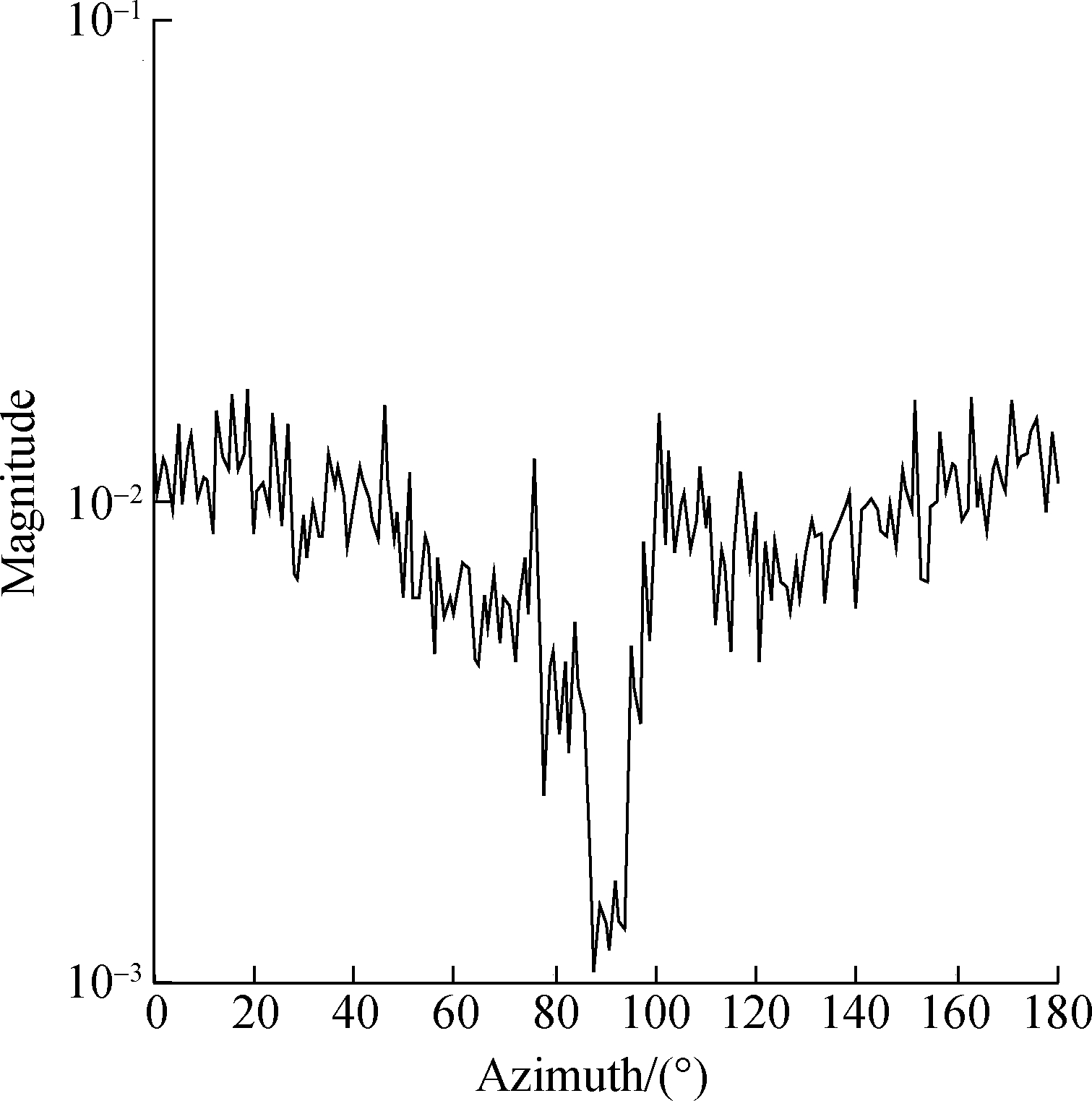
Fig.6 Tested SI for benchmark
For underwater targets like the benchmark, the time difference of echo highlights in keel-line is larger than that of beam direction. Correspondingly, the phase difference is larger, causing the strong fluctuation of echo spectrum. However, in the beam direction, the phases of different echo highlights are nearly the same, and the spectrum is more flat than that in other azimuths. The reason is that the benchmark SI is smaller in the beam direction and larger in other azimuths.
It should be noted that the results of experiments and theoretical simulation present some slight differences in some azimuths. This is mainly due to two causes. One is that the version of the planar element method model software used in this paper does not include elastic scattering, and the other is the fluctuation of broadband transmitting and receiving response.
2.2 SI in reverberation
For comparison, the reverberation SI of shallow water is simulated. The parameters are the same as those used in the simulation of the benchmark, namely the LFM signal of 20 to 40 kHz, with a pulse length of 3 ms.
The results of simulated reverberation are of 3 ms shown in Fig.7 and Fig.8. Fig.7 is the spectrum of simulated reverberation. Fig.8(a) is the waveform of simulated reverberation, containing the reverberation caused by the sea bottom and surface, and Fig.8(b) is the SI of the simulated reverberation varying with time. The results show that the SI of the reverberation does not vary notably with time.

Fig.7 Reverberation spectrum of the LFM signal of 20 to 40 kHz
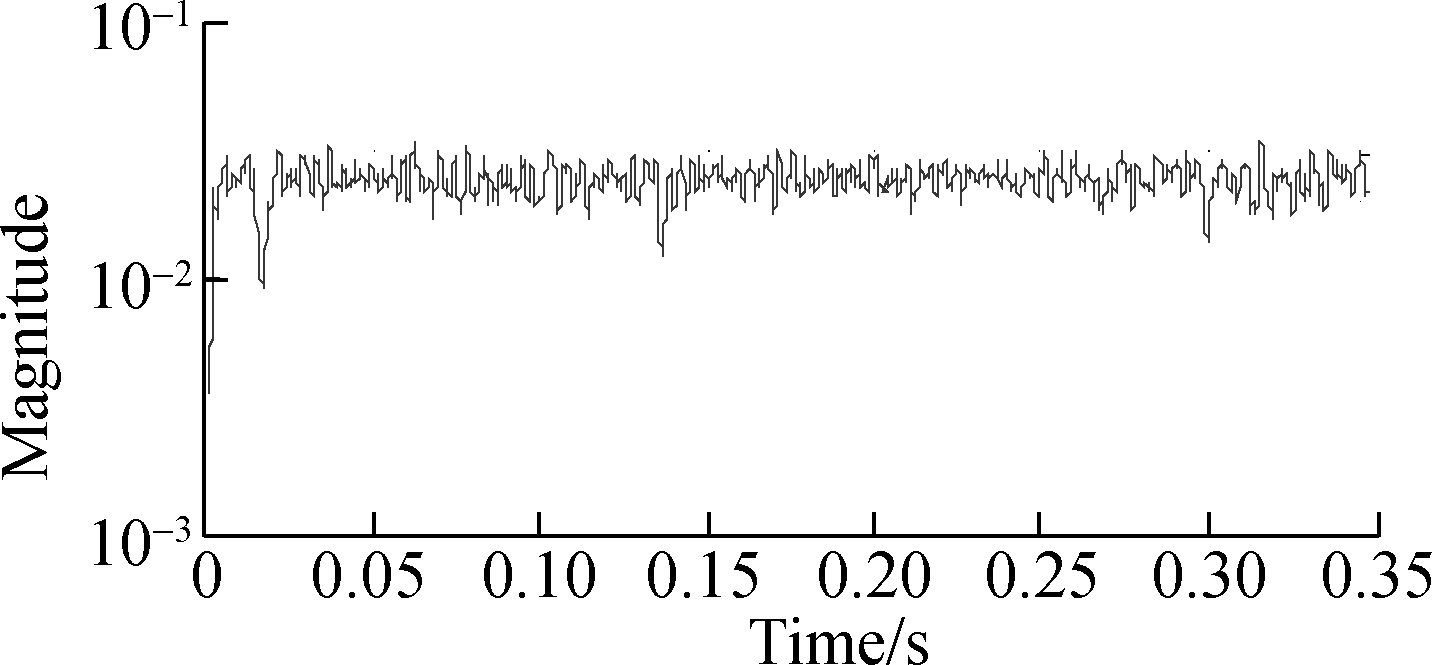
(a)
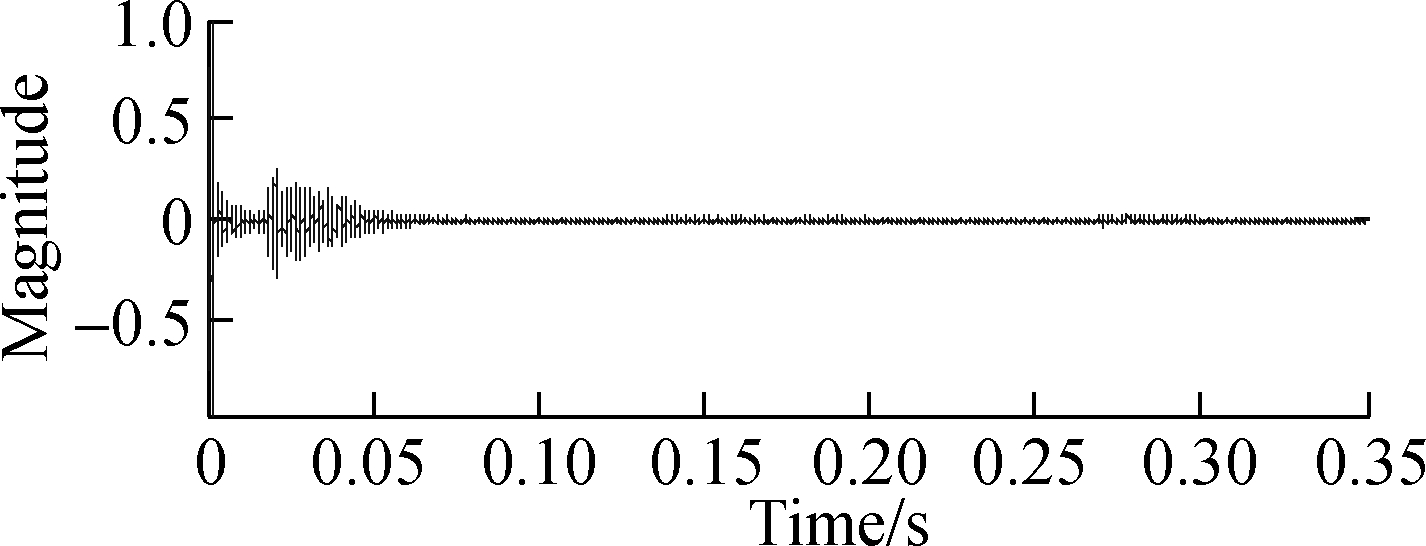
(d)
Fig.8 Reverberation SI of the LFM signal of 20 to 40 kHz. (a) Reverberation being processed; (b) SI result
In accordance with the theoretical predication, the SI of reverberation is notably larger than that of benchmark, which has a regular shape and smooth surface. Therefore, the difference in SI will be a useful feature for supporting the classification of the reverberation and man-made target in the water.
2.3 Target echo detection method based on SI feature
According to the theoretical and testing study of the complex echo spectrum, for a man-made target with a regular shape and smooth surface, the echo spectral irregularity is relatively small. But for the shallow water reverberation, the magnitude fluctuated notably in time and frequency domains. From the definition, the value of spectral irregularity for a data segment is determined by spectral magnitude and the difference of adjacent components. By signal spectral magnitude normalization, the value of spectral irregularity is mainly determined by the difference of adjacent components. For the detection of echo under strong reverberation, the spectrum of reverberation should be modulated by the superposition of echo and reverberation. The SI of echo with reverberation should be larger than the echo and smaller than the reverberation, depending on the signal to reverberation ratio (SRR).
Based on that characteristic, a method of echo detection under reverberation based on SI feature is proposed.
2.4 Scheme of the proposed method
For the discrimination between echo and strong reverberation background, the difference of SI between man-made target echo and reverberation can be the feature for classification. The data processing procedure shown in Fig.9 is as follows:
1) Filter the input data by a band-pass filter to minimize the interference.
2) Segment data with a certain overlap, and perform FFT transformation on the segmented data.
3) Normalize the data segments after FFT transformation for spectral magnitude consistency.
4) Compute SI value for the data, and the frequency band should be the same as the transmitting pulse.
5) Detect the minimum detection for the entire SI data sequence and obtain the detected echo.
For the validation of the method, the simulation of echo discrimination of benchmark with different SRRs is made.

Fig.9 Data processing procedure for discrimination between the echo and reverberation based on SI
3 Simulation and Real-Data Experiment
In this section, both simulations and real-data experiments are carried out to verify the proposed method.
3.1 Simulation results
Echo is simulated by the frequency indirect echo simulation method, and the computation of the target transfer function is based on PEM.
The simulations validate the performance of the proposed method with SRR varying from high to low. The incident pulse is the LFM signal of 20 to 40 kHz, the pulse length is 3 ms. The ratio of echo to reverberation changes from 3 to -10 dB.
The results of benchmark echo in 45°with three SRRs are given. Fig.10 and Fig.11 are the echo waveforms and corresponding results with a SRR of 3 dB, Fig.12 is the result with 0 dB SRR, and Fig.13 is the result with -10.0 dB SRR. For performance comparison, the features of SI and MF are processed. SI and MF in the figures refers to the spectral irregularity and matched filtering (MF) results, respectively, and the positions of the echo are marked by the rectangle.
Based on the simulation results, the SRR influences the performance of the method, and the performance is degraded with the decrease in SRR. When the SRR is below -10 dB, the method based on the SI feature can still detect the echo, but the performance of MF degrades dramatically.
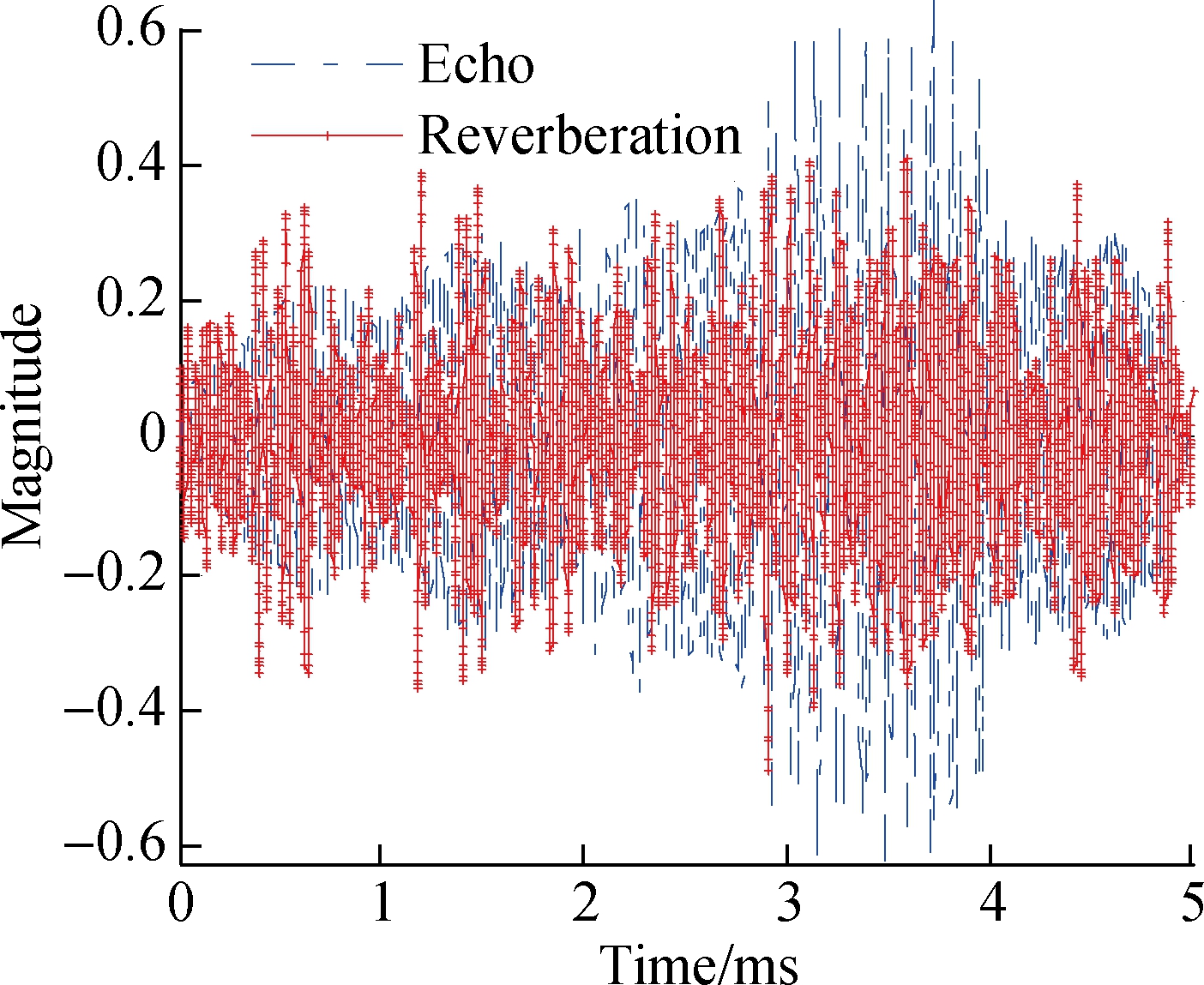
Fig.10 Waveform of echo and reverberation with 3 dB SRR

(a)

(b)

(c)
Fig.11 SI and MF processing results with 3dB SRR.(a) SI results; (b) Signal being processed; (c) MF result

(a)

(b)

(c)
Fig.12 SI and MF processing results with 0 dB SRR.(a) SI results; (b) Signal being processed; (c) MF result

(a)

(b)

(c)
Fig.13 SI and MF processing results with -10 dB SRR.(a) SI results; (b) Signal being processed; (c) MF result
The above simulation results show that the method can detect echo under reverberation effectively. Apart from the SRR, the performance of the method also depends on the azimuth, which is more effective for the beam direction and degrades in bow and stern direction.
3.2 Real-data experimental results
For further evaluating the feasibility of the proposed method on detection of echo with strong reverberation, a sea experiment is conducted. The target that is being tested is a scaled model. The transmitting signal is the LFM signal with 1 kHz bandwidth, and the center frequency is 5 kHz. The azimuths of the target are in the scope of 30° to 150°. For performance comparison, the feature of SI and MF are processed for the data with a sliding window, and for better time resolution, the data overlap should not be larger than one half of the window length.
Fig.14, Fig.15 and Fig.16 are the results of the three samples, respectively, in which the positions of echo are marked by the rectangle. The position of echo is estimated by the ranging information and the feature detection methods. The SRR of the first two samples are 4.2 dB and below 0 dB, respectively, and the azimuth is 33°. Sample Ⅲ is different, which has great reverberation interference near the echo. The positions of the largest interference are marked by a star.
The results of the three samples show that the positions of the echo can be easily estimated by minimum detection for the three samples by spectral irregularity. The position of the echo can be estimated by peak detection after matched filtering, but at the beginning of signal, the reverberation is still strong after matched filtering, which interferes with the detection of the echo, especially for sample Ⅲ.
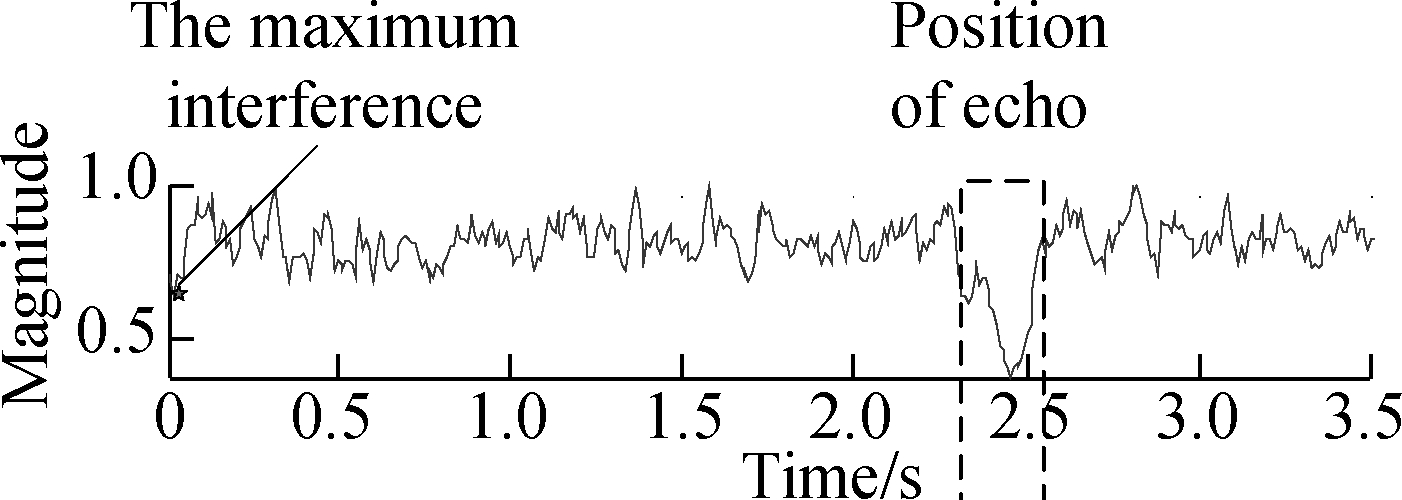
(a)

(b)

(c)
Fig.14 Results of samples Ⅰ.(a) SI results; (b) Signal being processed; (c) MF result
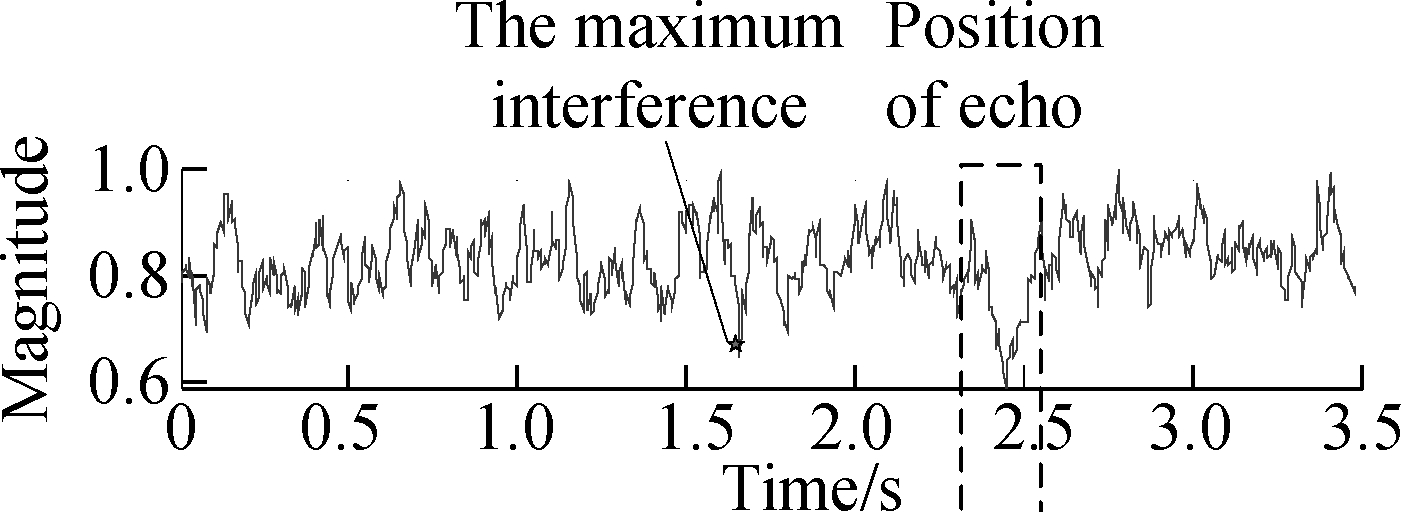
(a)

(b)

(c)
Fig.15 Results of samples Ⅱ. (a) SI results; (b) Signal being processed; (c) MF result

(a)

(b)

(c)
Fig.16 Results of Sample Ⅲ. (a) SI results; (b) Signal being processed; (c) MF result
The spectral irregularity of echo decreases with the decrease in the SRR, but it maintains notable difference of reverberation for the three samples. The spectral irregularity of reverberation fluctuates slightly with time, and the values of spectral irregularity do not vary with the magnitude of reverberation. For matched filtering, the performance of reverberation suppression degrades non-Gaussian reverberation, see the results in Fig.16.
Comparing the SI feature of echo with reverberation, the echo spectrum of a man-made target with regular shape and smooth surface fluctuates gently and the SI is smaller than that of reverberation. Based on that characteristic, the echo and reverberation can be classified by the SI feature. But, actually, the SI feature of benchmark varies with its azimuth; and the performance of echo detection also depends on the azimuth.
4 Conclusions
1) Through theoretical analysis, it is found that the intensity and intervals of acoustic scattering wave spectral fluctuation have a close relationship with the characteristic of echo highlights, SI, which characterizes the shape of the echo spectral envelope, can characterize the different physical properties of underwater targets.
2) The simulation and experiment results show that the SI of benchmark echo spectrum varies with azimuth, which is relatively greater in bow and stern direction and smaller on the beam direction.
3) The spectral irregularity of shallow water reverberation fluctuates slightly with time, and the values of SI do not vary with the magnitude of reverberation.
4) Sea experimental results show that the SI of echo is smaller than that of the reverberation with visible difference, demonstrating the feasibility of echo detection under reverberation based on the SI features.
5) The results of this paper mainly discuss the benchmark echo in shallow sea, the feasibility of which for other targets and different frequency bands will be studied in future work.
[1]Hui J Y, Sheng X L. Underwater sound channel [M]. 2nd Ed. Beijing: National Defense Industry Press, 2007: 121. (in Chinese)
[2]Zhu X, Zhao H F, Gong X Y. Detection of signals in reverberation noise [J]. Journal of Harbin Engineering University, 2004, 25(1): 34-37. (in Chinese)
[3]Kay S, Salisbury J. Improved active sonar detection using autoregressiveprewhiteness [J]. Journal of the Acoustical Society of America, 1990, 87(4):1603-1611. DOI:10.1121/1.399408.
[4]Song S J. Study on the method of target echo detection under reverberation background [D]. Harbin: College of Underwater Acoustic Engineering, Harbin Engineering University, 2008. (in Chinese)
[5]Sun W J. Studies on reverberation model and anti-reverberation signal processing for active sonar system [D]. Xi’an: College of Marine, Northwestern Polytechnical University, 2006. (in Chinese)
[6]Friedlander B, Zeira A. Detection of broadband signal in frequency and dispersive channel [J]. IEEE Transactions on Signal Processing, 1996, 44(7):1613-1622. DOI:10.1109/78.510610.
[7]Hermand J P, Roderick W I. Channel-adaptive matched filter processing of large time-bandwidth-product signal: Preliminary results [J]. Journal of the Acoustical Society of America, 1991, 89(4): 2001-2001. DOI:10.1121/1.2029845.
[8]Cai P, Liang G L, Ge F X, et al. Simulation research based on WVD-HT for anti-reverberation while detecting low doppler shift echo [J]. Journal of Harbin Engineering University, 2000, 21(3): 20-23. (in Chinese)
[9]Ge F X, Cai P, Hui J Y, et al. A new method for detecting the signal corrupted by the reverberation and estimation its parameters [J]. Acta Electronica Sinica, 2001, 29(3): 304-306. (in Chinese)
[10]Liu H B. The study of anti-reverberation technology [D]. Harbin: College of Underwater Acoustic Engineering, Harbin Engineering University, 2005. (in Chinese)
[11]Zhu G P. Study on technology for signal detection in the reverberation [D]. Harbin: College of Underwater Acoustic Engineering, Harbin Engineering University, 2009. (in Chinese)
[12]Flax L, Dragonette L R, Uberall H. Theory of elastic resonance excitation by sound scattering [J]. Journal of the Acoustical Society of America, 1978, 63(3): 723-731. DOI:10.1121/1.381780.
[13]Gaunaurd G C, Werby M F. Sound scattering by resonantly excited, fluid-loaded, elastic spherical shells [J]. Journal of the Acoustical Society of America, 1991, 90(5): 2536-2550. DOI:10.1121/1.402059.
[14]Brill D, Gaunaur C. Acoustic resonance scattering by a penetrable cylinder [J]. Journal of the Acoustical Society of America,1983, 73(5): 1448-1455. DOI:10.1121/1.389432.
[15]Gaunaurd G, Brill D. Acoustic spectrogram and complex-frequency poles of a resonantly excited elastic tube [J]. Journal of the Acoustical Society of America, 1984, 75(6): 1680-1693. DOI:10.1121/1.389432.
[16]Tesei A, Fox W L J, Maguer A, et al. Target parameter estimation using resonance scattering analysis applied to air-filled, cylindrical shells in water [J]. Journal of the Acoustical Society of America, 2000, 108(6): 2891-2900. DOI:10.1121/1.1312359.
[17]Tang W L, Fan J. Mechanisms of sound scattering and radiation of submerged elastic structure-vibro-acoustic coupling of structure and water [J]. Acta Acustica, 2004, 29(5): 385-392.
[18]Pan A, Fan J, Zhuo L K. Acoustic scattering from a periodically bulkhead cylindrical shell [J]. Acta Physica Sinica, 2012, 62(2): 214301-1-214301-11. (in Chinese)
[19]Pan A, Fan J, Zhuo L K. Acoustic scattering from a finite quasi-periodic bulkhead cylindrical shell [J]. Acta Physica Sinica, 2013, 62(2): 024301-1- 024301-10. (in Chinese)
[20]Rajabi M, Seyyed M. Acoustic resonance scattering from a multilayered cylindrical shell with imperfect bonding [J]. Ultrasonics, 2009, 49: 682-695. DOI:10.1016/j.ultras.2009.05.007.
[21]Jones B A, Stanton T K, Lavery A C, et al. Classification of broadband echoes from prey of a foraging Blainville’s beaked whale [J]. Journal of the Acoustical Society of America, 2008, 123(3): 1753-1762. DOI:10.1121/1.2828210.
[22]Branstetter B K, Mercado Ⅲ E, Au W L. Representing multiple discrimination cues in a computational model of the bottlenose dolphin auditory system [J]. Journal of the Acoustical Society of America, 2007, 122(4): 2459-2468. DOI:10.1121/1.2772214.
[23]Pailhas Y, Capus C, Brown K. Analysis and classification of broadband echoes using bio-inspired dolphin pulses [J]. Journal of the Acoustical Society of America, 2010, 127(6): 3809-3820. DOI:10.1121/1.3372754.
[24]Genzel D, Wiegrebe L. Time-variant spectral peak and notch detection in echolocation-call sequences in bats [J]. The Journal of Experimental Biology, 2008, 211: 9-14. DOI:10.1242/jeb.012823.
[25]Nell C W, Gilroy L E. An improved BASIS model for the BeTSSi submarine [R]. DRDC Atlantic TR, 2003.
[26]Wu J R, Peng D Y, Zhang J L. The characteristics of ocean reverberation [J]. Physics, 2014, 43(11): 732-739.
[27]Liu B S, Lei J Y. Principles of underwater sound [M]. 2nd Ed. Harbin: Harbin Engineering University Press, 2010:190. (in Chinese)
[28]Tang W L. Highlight model of echoes from sonar targets [J]. Acta Acustica, 1994, 19(2): 92-99. (in Chinese)
[29]Chen K A. The sensing and auto classification of environmental sound [M]. Beijing: Science Press, 2014:199. (in Chinese)
[30]Fan J, Zhu B L, Tang W L. Modified geometrical highlight model of echoes from non-rigid surface sonar target [J]. Acta Acustica, 2001, 26(6): 545-550. (in Chinese)
[31]Fan J, Li J L, Liu T. Transition characteristics of echoes from complex shape targets in water [J]. Journal of Shanghai Jiaotong University, 2002, 36(2): 161-164. (in Chinese)
[32]Fan J, Tang W L, Zhuo L K. Planar elements method for forecasting the echo characteristics from sonar targets [J]. Journal of Ship Mechanics, 2012, 16(1/2): 171-180. (in Chinese)